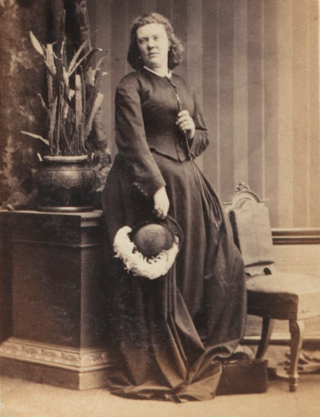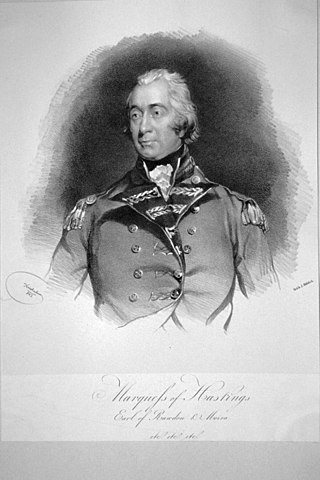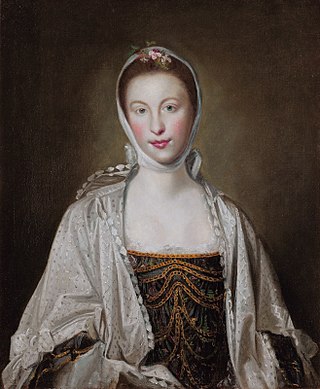
Earl of Loudoun, named after Loudoun in Ayrshire, is a title in the Peerage of Scotland. It was created in 1633 for John Campbell, 2nd Lord Campbell of Loudoun, along with the subsidiary title Lord Tarrinzean and Mauchline. The 1st Earl's wife Margaret was the granddaughter and heiress of Hugh Campbell, who had been created Lord Campbell of Loudoun; he resigned the peerage in favour of his grandson-in-law, who was later created an earl.

Earl of Huntingdon is a title which has been created several times in the Peerage of England. The medieval title was associated with the ruling house of Scotland.

Baron Hastings is a title that has been created three times. The first creation was in the Peerage of England in 1290, and is extant. The second creation was in the Peerage of England in 1299, and became extinct on the death of the first holder in c. 1314. The third creation was in the Peerage of England in 1461, and has been in abeyance since 1960.

Baron Hungerford is a title in the Peerage of England. It was created on 7 January 1426 for Walter Hungerford, who was summoned to parliament, had been Member of Parliament, Speaker of the House and invested as Knight of the Order of the Garter before and was made Lord High Treasurer one year before he became a peer. The man who would later succeed as third baron was created Baron de Moleyns on 13 January 1445 by writ of summons; both titles merged when he succeeded as Baron Hungerford in 1459. The third baron was attainted and the peerage forfeit in 1461. This attainder was reversed in 1485 for the then 4th baroness of Hungerford, and so it came into the Hastings family of Earls of Huntingdon until 1789, when it came into the Rawdon(-Hastings) family of the Marquesses of Hastings until 1868 when it fell into abeyance. This abeyance was terminated three years later for a member of the Abney-Hastings family and an Earl of Loudoun. In 1920 it again fell into abeyance, which was terminated one year later for the Philipps family of the Viscounts of St Davids where it has remained since.

Marquess of Hastings was a title in the Peerage of the United Kingdom. It was created on 6 December 1816 for Francis Rawdon-Hastings, 2nd Earl of Moira.

Edith Maud Rawdon-Hastings, 10th Countess of Loudoun was a Scottish peer. She died aged 40 after caring for Rowallan Castle. Sir George Gilbert Scott designed an Eleanor Cross style monument to her which was erected in Ashby de la Zouch.

Loudoun Castle is a ruined 19th-century country house near Galston, in the Loudoun area of Ayrshire, Scotland. The ruins are protected as a category A listed building.
British history provides several opportunities for alternative claimants to the English and later British Crown to arise, and historical scholars have on occasion traced to present times the heirs of those alternative claims.

George Augustus Francis Rawdon-Hastings, 2nd Marquess of Hastings, styled Lord Rawdon from birth until 1817 and Earl of Rawdon from 1817 to 1826, was a British peer and courtier.
Elizabeth Frances Philipps, Viscountess St Davids was a British peeress. Following the passing of the Peerage Act 1963, she became the first woman to take her seat in the House of Lords by virtue of an hereditary peerage as 14th Baroness Strange of Knokin.
Edith Maud Abney-Hastings, 12th Countess of Loudoun was a British peeress.

Sir Charles Abney Hastings, 2nd Baronet of Willesley Hall, Derbyshire was both High Sheriff of Derbyshire and an MP for Leicester from 1826 to 1831.
Francis Hastings, Lord Hastings was the son of George Hastings, 4th Earl of Huntingdon and Dorothy Port. He married Sarah Harington, daughter of Sir James Harington and Lucy Sydney. They had five children:

Elizabeth Rawdon, Countess of Moira in the Peerage of Ireland was a literary patron and antiquarian; she also held five English peerages in her own right. She was born at Donington Park, Leicestershire, England and died at Moira, County Down, Ireland.
Charles Edward Rawdon-Hastings, 11th Earl of Loudoun was a Scottish peer.

Henry Weysford Charles Plantagenet Rawdon-Hastings, 4th Marquess of Hastings and 9th Earl of Loudoun, styled Lord Henry Rawdon-Hastings from birth until 1851, was a British peer. He was also, starting from most senior barony, 21st Baron Grey of Ruthyn, 20th Baron Botreaux, 19th Baron Hungerford, and 17th Baron Hastings.

The Hastings, later Abney-Hastings Baronetcy, of Willesley Hall in the County of Derby, was a title in the Baronetage of the United Kingdom. It was created on 28 February 1806 for the soldier Sir Charles Hastings. He was the illegitimate son of Francis Hastings, 10th Earl of Huntingdon. Hastings married Parnel Abney, daughter and heiress of Thomas Abney, of Willesley Hall, Willesley, Derbyshire, and granddaughter of Sir Thomas Abney, Justice of the Common Pleas. He was succeeded by his eldest son, Charles, the second Baronet, who assumed, by Royal Licence dated 1 December 1823, the additional surname of Abney, before that of Hastings, on succeeding to the Abney estates through his mother. Abney-Hastings represented Leicester in Parliament between 1826 and 1831. The title became extinct on his death in 1858. Abney-Hastings's Blackfordby and Packington estates passed to his kinsman Henry Rawdon-Hastings, 4th Marquess of Hastings, while Willesley Hall was left to Lady Edith Maud Rawdon-Hastings, later Countess of Loudoun, the Marquess's eldest sister and wife of Charles Frederick Clifton, who in 1859 assumed the surname Abney-Hastings.
Bertha Lelgarde Clifton, 22nd Baroness Grey de Ruthyn was a British aristocrat.
Paulyn Reginald Serlo Rawdon-Hastings, 3rd Marquess of Hastings, styled Earl of Rawdon from birth until 1844, was a British peer and officer in the British Army.
Gilbert Theophilus Clifton Clifton-Hastings-Campbell, 3rd Baron Donington was a British peer and soldier.










